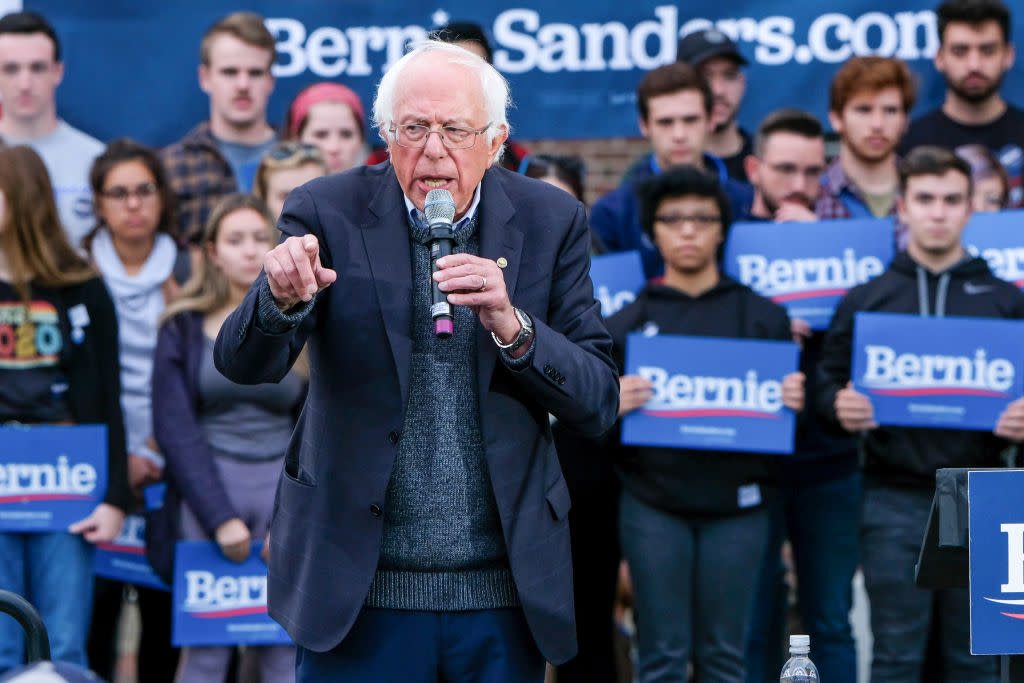Bernie Sanders hospitalized for blocked artery, stent procedure — here’s what recovery will look like

Presidential candidate Bernie Sanders was hospitalized Tuesday night after experiencing chest pains during a campaign event in Las Vegas.
A medical evaluation revealed a blocked artery in the 78-year-old Vermont senator, prompting a heart procedure in a Las Vegas hospital in which doctors inserted two stents — tiny wire mesh tubes designed to keep blocked arteries open, restoring blood flow.
Although a blocked artery sounds serious, it’s common. “Coronary disease is very common,” Jon Resar, MD, director of adult cardiac catheterization laboratory at Johns Hopkins Medicine, tells Yahoo Lifestyle, noting that former President Bill Clinton had quadruple coronary bypass surgery in 2004 (followed by stent surgery in 2010) and former President George W. Bush had a blocked coronary artery and a stent inserted in 2003.
In the procedure (also known as angioplasty), which is done under sedation, a small incision is made in the wrist or groin to access an artery. A guidewire, followed by a catheter, is then threaded through the artery until it reaches the blockage, according to the Mayo Clinic. Contrast dye is injected and then pictures are taken to get a good visual of the blockage, explains Resar. A small balloon attached to the catheter is inflated, opening up the blocked artery, and then a stent is inserted to keep the passage open.
“We do the process from the wrist instead of from the leg,” says Resar. “Recovery is easier. You’re able to sit up and eat immediately after the procedure. There’s also a decreased risk of bleeding.”
After the procedure, Sanders “would be able to resume all of his normal campaign activities without really any downtime,” says Resar, who has not treated Sanders. “Patients are often home the same day. My anticipation is he’ll be back on the campaign trail.”
Resar also notes that Sanders’s physician will focus on ways the presidential candidate can reduce any risk factors for coronary artery disease, such as eating a healthier diet (“On the campaign trail, they eat a lot of junk food,” notes Resar), exercise and likely cholesterol-lowering medication — a statin — if Sanders is not taking one already. “Stress does play a role, but it’s down on the list,” says Resar.
Based on a statement from Sanders’s senior adviser, Jeff Weaver, released on Wednesday, it sounds like the senator is recovering well: "Sen. Sanders is conversing and in good spirits,” it reads. “He will be resting up over the next few days. We are canceling his events and appearances until further notice, and we will continue to provide appropriate updates.”
In the meantime, Sanders, who remains hospitalized, has received an outpouring of support from fans and other politicians on social media.
.@DrBiden and I are sending our best wishes to @BernieSanders, Jane, and the whole Sanders family. Anyone who knows Bernie understands what a force he is. We are confident that he will have a full and speedy recovery and look forward to seeing him on the trail soon.
— Joe Biden (@JoeBiden) October 2, 2019
Thinking of @BernieSanders today and wishing him a speedy recovery. If there's one thing I know about him, he's a fighter and I look forward to seeing him on the campaign trail soon.
— Kamala Harris (@KamalaHarris) October 2, 2019
Bruce, Team Warren, and I are sending all our best wishes for a speedy recovery to @BernieSanders. I hope to see my friend back on the campaign trail very soon.
— Elizabeth Warren (@ewarren) October 2, 2019
Sending prayers to Senator Sanders, his family and loved ones. https://t.co/j9hot2Hqpt
— Meghan McCain (@MeghanMcCain) October 2, 2019
At this time we must put all political conversations aside and wish with all our hearts for the health of Senator Sanders.
— Dan Rather (@DanRather) October 2, 2019
Read more from Yahoo Lifestyle:
Follow us on Instagram, Facebook and Twitter for nonstop inspiration delivered fresh to your feed, every day.
